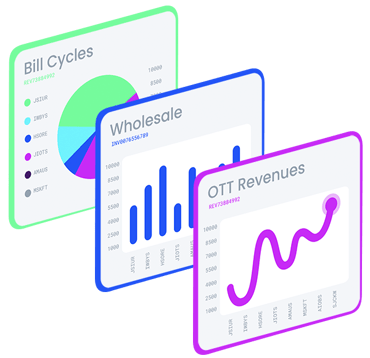In the ever-evolving realm of telecommunications, the pivotal role of billing and charging systems in service delivery and revenue generation cannot be overstated. Within this landscape, Converged Charging Systems (CCS) and Online Charging Systems (OCS) emerge as two indispensable components, each characterized by its unique functions and features. But what's the difference between OCS and CCS? This article aims to dissect the disparities between CCS and OCS, shedding light on their profound impact on the telecommunications industry.

The standards for OCS (Online Charging System) and CCS (Converged Charging System) are predominantly driven by the 3GPP (3rd Generation Partnership Project). While the OCS specifications have been formulated to address the requirements of 4G, the CCS specifications have evolved to accommodate the demands of 5G.
An OCS is a system used by telecommunications service providers to bill their clients in real-time for services such as voice calls, data consumption, SMS, and so on. It ensures that clients are immediately charged for the services they use, and it also allows service providers to use a variety of billing and rating schemes. OCS is essential for prepaid services since it ensures that clients do not exceed their available amount but is also used to control postpaid to avoid and prevent bill shock.
The modern CCS, on the other hand, is a more sophisticated and flexible charging technology. It is intended to manage both prepaid, postpaid services and hybrid in a unified manner. It supports the huge diversity of 5G charging parameters and use cases. This means that, like OCS, it can manage real-time charging while still providing the functionality required for postpaid billing cycles. CCS systems are frequently integrated into larger business support systems (BSS) and are meant to be adaptable to a variety of billing models, discounts, promotions, complex tariff structures and other sophisticated control points than a regular OCS, like real-time credit control.
Unlike traditional OCS commonly used for Real-Time Credit Control & Charging, CCS has a broader set of features, such as:
- Supports account hierarchy, allowing operators to easily manage hierarchies. This allows to, for instance, to set up resellers with flexible hierarchies below them and provide granular and seamless control to fleet managers to manage their SIMs. It’s possible to capitalize on the hierarchies with Group functionalities to engage businesses, families and communities;
- Can support multiple network types, including 4G/LTE, 5G;
- It can handle charging for multiple services in a converged manner, whether it is event-based charging or session-based charging, allowing for more flexibility in billing and pricing models;
- Limits and allowances can be shared on each service, being Voice, Data, Video, or others. It can be based on geographic destinations, day of the week, holidays, customer profiles or other rules – the possibilities are endless;
- Supports both real-time and offline charging with the capability to store charging information for later batch processing. This can be useful for generating billing records, analyzing usage patterns, and performing other backoffice operations;
- Embedded Policy Control Functions - may have integration with both Policy Control and OCS but has a broader scope in managing charging for multiple services, which is useful to block, limit or downgrade access to services (necessary for parental control and emergency services);
- Relies on TMForum OPEN APIS for increased interoperability to facilitate integrations;
- CCS can be a key source of events and Contextual Triggers regarding the customer journey, which can utilized to engage with the customer base in a contextual, meaningful and timely manner by using Event Intelligence.
Overall, an OCS focuses on real-time, prepaid charges, but a CCS is full convergence, not limited to prepay and controlled postpaid (i.e. Hybrid), but also mobile technologies from 2G/3G, 4G, 4, 5G to 5G, including VoLTE as well as broadband with dual Diameter and HHTP2.0 SBA APIs, ALL with one system. The architecture and design philosophy behind 5G differs significantly from 3G and 4G. 5G also brings exponential increases in both the volume and variety of usage events. This opens the doors to new use cases in the business segment, such as 5G network slicing. CCS is best equipped to support the needs of operators and fuel 5G use cases.
The list below details the key use cases for OCS and CCS.
OCS and CCS Telecom Use Cases:
- Enable real-time charging for data usage by monitoring and charging subscribers based on their data consumption preventing postpaid bill shock;
- Allows dynamic service packages that can include various combinations of data, voice, and messaging services, roaming, and much more;
- Allows the implementation of real-time promotions and discounts;
- Integrated with PCRF to enforce policy control in real time;
- Fraud Detection and Prevention: by monitoring unusual or suspicious patterns of usage in real time. This helps identify and prevent fraudulent activities promptly;
- Family or Group Plans: Reward end users for adding friends and family to a group plan while reducing the cost of onboarding customers;
- Payback: ‘Give back’ to end users their unused data or bundle allowances as a discount as a payment or discount;
- Membership Scheme: Reward subscribers with loyalty points;
- Charity: Deliver funds to your charity through service usage and donations of un-used bundle allowance or cash balance;
- Gift Bundles: Provide free, limited period, ad-hoc data or service bundle to celebrate an occasion;
- Recurrent Incentives: Provide a recurring data or service usage gift to incentivise service or contract subscription or renewal;
- Reward Loyalty: Reward on-time payers with bonus data to boost the number of end users who pay their bills on time;
- Roaming: Offer bespoke roaming add-ons tailored to different customer segments;
- 5G Slicing: CCS’s 5G Core and service-based architecture delivers the ability to slice the network. Each "slice" is an isolated end-to-end network that can be customized for different applications, services, or customers;
- Expansion in the B2B segment: with 5G, different slices could be used for innovative business cases, such as IoT and low-latency applications, allowing mobile operators to expand their revenue streams and provide highly customized network services to their business customers.
Drawing an analogy, we can assert that many telecom companies may not know whether they require an OCS or a CCS (Converged Charging System) until they understand its functionality. To illustrate, consider the construction industry. Just as constructing a house requires the foundational element of bricks, transforming these bricks into a structured and upgraded house involves a process. In this analogy, think of OCS as the initial brick that, akin to a 5G evolution for 4G networks, plays a crucial role in building a flexible, future proof, 5G ready and scalable structure—the CCS.
Take the first step towards building a flexible and robust network infrastructure by exploring how our real time charging solutions can elevate your telecommunications capabilities. Contact us now to schedule a free consultation and ensure your network is well-equipped for the demands of tomorrow.


